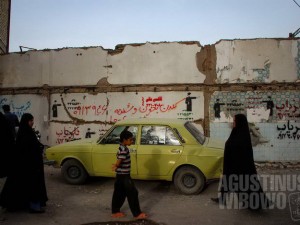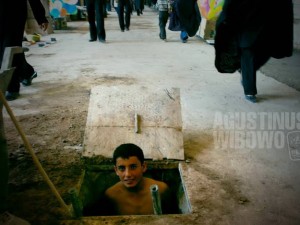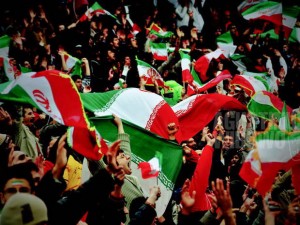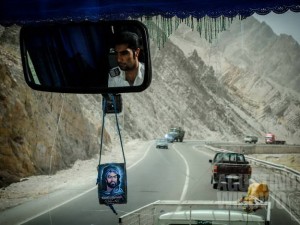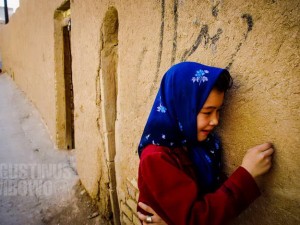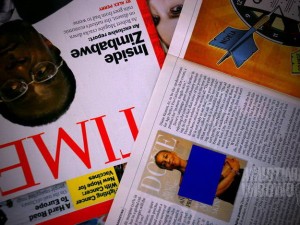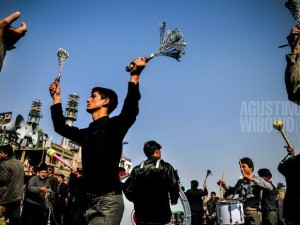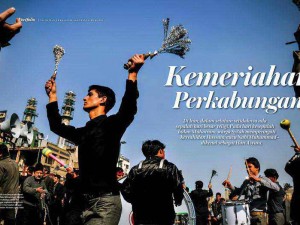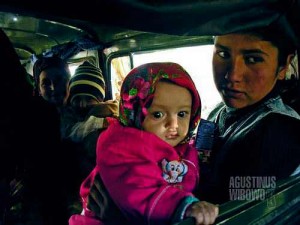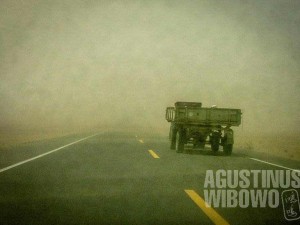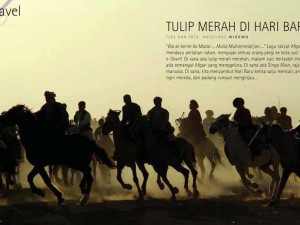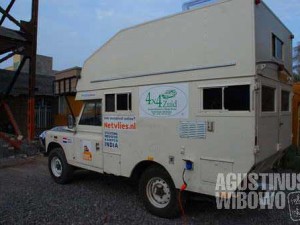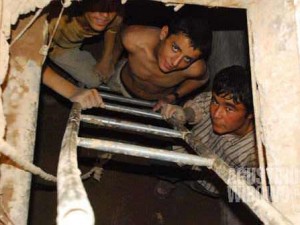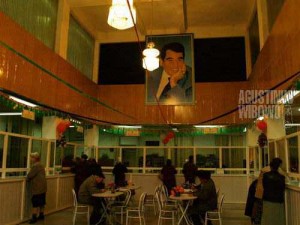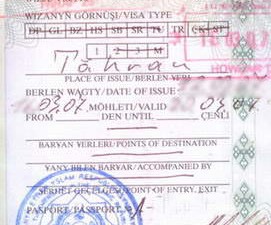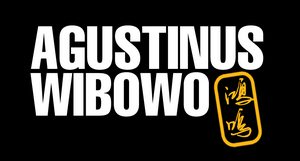Iran
Devastated (Bam, IRAN, 2008) 27 December 2003, the small town of Bam – located in southeastern Iran, about 300 kilometers from Kerman – was rocked by 6.8 Richter-scale earthquakes. More than 40,000 were killed. Asides from the human casualty, Iran also grieved the loss of one of their civilization jewels. The ancient city of thousands years old in Bam was nothing but flattened. Five years after the earthquake, rubbles are still seen here and there in Bam, but live starts to get normal again. As it is bordering with the problematic province of Sistan-e-Balochestan, security is still an issue in Bam. Kidnappings of foreign visitors happen sporadically, and during certain period of time, foreigners have to be accompanied by armed guards while traveling around the town. Hancur Lebur (Bam, IRAN, 2008) Pada 27 Desember 2003, kota kecil Bam di Iran tenggara, dilanda gempa dahsyat berkekuatan 6,8 Skala Richter. Lebih dari 40 ribu orang tewas dalam bencana itu. Selain korban jiwa, Iran juga meratapi hilangnya salah satu permata peradaban mereka. Kota kuno Bam yang sudah berusia ribuan tahun hancur diratakan oleh gempa. Lima tahun sesudah malapetaka itu, puing-puing kehancuran masih terlihat nyata di Bam, walaupun kehidupan sudah mulai normal. Bam berbatasan [...]
#1Pic1Day: Bekerja di Bawah Tanah | Working Underground (Kerman, IRAN, 2008)
Working Underground (Kerman, IRAN, 2009) Bordering with warring and unstable Afghanistan, Iran has harbored millions of refugees coming from its troublesome neighbor. With their own burden of economic hardship and national security, Iranian government has to impose severe restrictions against Afghan immigrants. Job opportunities to the Afghans in Iran are limited to informal sector, and children are not allowed to go to Iranian schools. Security check is also frequent towards the Afghans, as Iran has put strict time limit for the immigrants to go back to their country. Despite of all the restrictions, Iran still receives huge influx of illegal immigrants from Afghanistan, as they still regard Iran is still promising economically compared to their war-torn homeland. Bekerja di Bawah Tanah (Kerman, IRAN, 2009) Berbatasan langsung dengan Afghanistan berarti Iran harus menampung jutaan pengungsi dari negara tetangganya yang selalu problematik itu. Dengan beban ekonomi yang berat dan juga alasan keamanan nasional, pemerintah Iran terpaksa menerapkan pembatasan yang ketat terhadap imigran Afghan. Kesempatan kerja orang Afghan di Iran dibatasi di bidang informal, dan anak-anak mereka tidak boleh bersekolah di sekolah Iran. Pemeriksaan polisi sangat sering dilakukan terhadap orang Afghan, dan Iran telah menetapkan batas waktu yang jelas supaya para imigran Afghan [...]
#1Pic1Day: Nasionalisme di Lapangan Sepakbola | Nationalism on Football Field (Tehran, IRAN, 2009)
Nationalism on Football Field (Tehran, IRAN, 2009) Iran has among the most powerful national football team in Asia. As anywhere in the world, football match is not merely a sport event, but also a “war zone” of nationalism and superiority. Famous for their fanaticism, Iranian supporters have the power to shake the whole stadium, especially if their national team is fighting against any of the Arab countries. According to the law of the Islamic Republic, only men are admitted entry to the stadium. Nasionalisme di Lapangan Sepakbola (Teheran, IRAN, 2009) Tim nasional sepak bola Iran termasuk yang terkuat di Asia. Seperti di negara lainnya di dunia, pertandingan sepak bola bukanlah even olahraga semata, tetapi juga sebuah “medan perang”, pertarungan dari nasionalisme dan superioritas. Suporter sepak bola Iran terkenal dengan fanatisme mereka, punya kemampuan penuh mengguncang seluruh stadium, apalagi jika tim nasional mereka berhadapan dengan tim dari negara Arab mana pun. Menurut aturan dari pemerintah Republik Islam, hanya lelaki yang diizinkan masuk ke [...]
1Pic1Day: Sang Pahlawan | The Hero (Iran, 2008)
The Hero (Balochestan, Iran, 2008) In majority Shiite Iran, Hossein ibn Ali—the Prophet’s grandson and Ali’s son—has special position in people’s heart. Hossein was killed in the Battle of Karbala when fighting against his enemies in the 7th century. His death is marked as the most important religious event in Iran, known as Ashora, but also nicknamed as “the Festival of Hossein”, and remembered—if not celebrated—in Iran in full swing festivities. The sacrifice of Hossein, the fighting of the virtue of the minority against the vice of the majority, somehow properly fit the image of how Iran sees itself in its journey of history. The adoring of Hossein is deep-rooted in Iranian society, fully manifested in their religious rituals, art and culture. Hossein face is never far away from the people’s life, always placed in respected locations. Sang Pahlawan (Balochestan, Iran, 2008) Di negeri Syiah Iran, cucu nabi Muhammad SAW, Hossein ibn Ali memiliki posisi yang sangat istimewa di hati masyarakat. Hossein terbunuh dalam Perang Karbala di abad ke-7. Hari kematiannya adalah even religius terpenting di Iran, dikenal sebagai Ashora, tetapi juga dijuluki sebagai “Hari Raya Hossein”. Hari kematian itu diperingati, kalau tidak bisa disebut sebagai dirayakan, dengan nuansa [...]
#1Pic1Day: Namaku Pengungsi | Growing Up as Refugee (Iran, 2008)
Growing Up As Refugee (Yazd, Iran, 2008) Most of about a million Afghan nationals living in Iran are refugees, fled their war-torn country during the 1980s Soviet war and 1990s Taliban regime. The majority of the refugees are the Shiite Hazara who receives prosecution under the Taliban. Despite of their religious bond with the Shiite Iran, the Afghan refugees are treated with suspiciousness, discrimination and sometimes hostility. They cannot obtain Iranian citizenship or permanent residency, and the children have no rights to receive proper education. Iran-Afghanistan porous border is also infamous for people and drug smuggling. Namaku Pengungsi (Yazd, Iran, 2008) Sebagian besar dari 1 juta warga Afghan yang tinggal di Iran adalah para pengungsi yang melarikan diri dari negeri mereka yang dilanda perang berkepanjangan, terutama pada era 1980-an saat perang melawan Soviet dan era 1990-an pada masa rezim Taliban. Kebanyakan para pengungsi adalah etnis Syiah Hazara yang mengalami pembantaian pada masa Taliban. Walaupun secara agama mereka dekat dengan masyarakat Iran yang mayoritas Syiah, para pengungsi Afghan selalu dicurigai, didiskriminasi, dan sering kali dibenci. Mereka tidak bisa memperoleh kewarganegaraan Iran atau izin tinggal permanen, dan anak-anak mereka tidak bisa ke sekolah. Perbatasan Iran-Afghanistan yang sangat longgar menjadi pintu [...]
#1Pic1Day: Too Sexy (Iran, 2008)
Too Sexy (Tehran, Iran, 2008) Too Sexy (Iran, 2008) The government of the Islamic Republic of Iran imposes strict regulations on dressing code. Pictures of women in printed materials are censored whenever regarded as un-Islamic. Terlalu Seksi (Iran, 2008) Pemerintah Republik Islam Iran menerapkan aturan cara berpakaian yang sangat ketat. Gambar perempuan pada majalah pun disensor apabila dinilai tidak [...]
#1Pic1Day: Festival of Death (Iran, 2010)
Festival of Death / Festival Kematian (Mashhad, Iran, 2008) Festival of Death (Mashhad, Iran, 2008) Black is the color dominating important dates in Iran. Men-in-black parade through the boulevards. They beat their heads and chests, flagellate their backs with metal chains. Sometimes you hear weep and mourning amid busy band noise and harmonious chanting. Most of important religious events in Iran are related to martyrdom of the saints, and are commemorated in full swing. The most important event is Ashora (Martyrdom of Imam Hussain) and Arbain (40 days after the Martyrdom of Imam Hussain). In this picture is commemoration of the Demise of Prophet Muhammad (PBUH) and Martyrdom of Imam Hassan. Festival Kematian (Mashhad, Iran, 2008) Hitam adalah warna yang mendominasi hari-hari besar di Iran. Para lelaki berbaju hitam berarak menyusuri jalan. Dada dan kepala ditepuk, rantai dipukulkan ke punggung, sesekali terdengar tangis susul-menyusul di tengah dentuman suara band dan lantunan doa berirama. Di antara hari-hari besar religius di Iran, mayoritas memang berupa peringatan kematian dan diperingati secara kolosal. Yang terpenting adalah hari Ashora (peringatan kesyahidan Imam Hussain) dan Arbain (peringatan 40 hari setelah kesyahidan Imam Hussain). Dalam gambar ini adalah ritual peringatan wafatnya Rasulullah dan kesyahidan [...]
Garis Batas 61: Pancaran Sinar Lazuardi
Reruntuhan Masjid Bibi Khanym (AGUSTINUS WIBOWO) Ratusan tahun lalu, kota ini pernah menjadi pusat dunia. Di sinilah segala macam bangunan raksasa, mercu suar peradaban dunia, berdiri dengan segala keanggunannya. Puing-puing reruntuhan Masjid Bibi Khanym, yang pada zamannya pernah menjadi bangunan tertinggi di dunia, dibangun oleh sang Raja Amir Timur sebagai lambang cintanya untuk permaisuri tersayang dari negeri Tiongkok, masih menggambarkan kebesaran dan kejayaan negeri ini. Belum lagi barisan kuburan indah di kota makam bernama Shakhr-i-Zinda, yang diperuntukkan bagi Sang Raja Hidup yang membawa cahaya Islam ke tengah padang Asia Tengah. Bait-bait puisi mengalir bak air bah, di bawah kegagahan gedung-gedung kuno. Bintang, planet, galaksi ditemukan dari teropong panjang milik Ulughbek. Barisan karavan para saudagar tak pernah berhenti singgah di kota yang semakin hiruk pikuk oleh berbagai aktivitas perdagangan. Sinar lazuardi tak pernah berhenti memancar dari keagungan Samarkand. Samarkand memang tak pernah mati. Samarkand sekarang adalah ibu kota Samarkand Viloyati atau Provinsi Samarkand, kota terbesar kedua di Uzbekistan dengan jumlah penduduk hampir setengah juta jiwa. Musim panasnya menyengat, musim dinginnya bermandi salju. Tetapi nama Samarkand, yang senantiasa hidup dalam angan mimpi dan fantasi, adalah sebuah Samarkand yang dipenuhi alunan musik padang pasir, membahana memuja kemajuan peradaban. Zaman terus berputar. Gedung-gedung raksasa [...]
National Geographic Traveler Indonesia (2013): Kemeriahan Perkabungan
Portfolio | Foto dan Teks oleh Agustinus Wibowo Di Iran, dalam setahun setidaknya ada sepuluh hari besar religi. Pada hari kesepuluh bulan Muharram, warga Syi’ah memperingati kesyahidan Hussain, cucu Nabi Muhammad—dikenal sebagai Hari Asyura. Para umat di Iran berparade di hari wafatnya Nabi Muhammad. Mereka memukul-mukulkan rantai ke dada sebagai ungkapan kesedihan. Peringatan ini bertepatan dengan hari kesyahidan Hassan, cucu Nabi. Hitam adalah warna yang mendominasi. Lelaki, juga berbaju hitam, berarak menyusuri jalan. Dada dan kepala ditepuk, rantai dipukulkan ke punggung, sesekali terdengar tangis susul-menyusul. Sebuah peringatan kematian. “Tidak ada darah dalam peringatan di Iran. Itu dilarang pemerintah. Kau lihat sendiri, kami memperingati hari besar kami dengan cara beradab,” kata seorang umat dari pinggiran Teheran. Lantunan doa memenuhi angkasa. Menggelegar pula suara tetabuhan band mengiringi para lelaki yang berbaris, berparade sepanjang jalan. Pertempuran di medan Karbala ditampilkan sebagai pertunjukan teater di masjid dan jalanan. Lelaki berbaju zirah memerankan tokoh Hussain yang gagah, menunggang kuda putih menantang Yazid yang lalim. Bait-bait puisi Persia mendayu, diiringi merdunya denting dawai. Drama berlangsung hingga tengah malam. Pada puncaknya, para lakon menggambarkan bagaimana satu demi satu anggota keluarga Hussain meninggal dengan mengenaskan. Mereka menyebut ritual tahunan ini “Festival Hussain.” Sebuah perkabungan yang menjadi [...]
Garis Batas 2: Selamat Datang di Tajikistan
Perempuan Tajikistan di dalam bus, bebas bercampur dengan penumpang pria. Sebuah kontras dibandingkan Afghanistan di seberang sungai yang sangat konservatif (AGUSTINUS WIBOWO) Kota terakhir Afghanistan adalah Shir Khan Bandar, di tepian sungai lebar bernama Amu Darya. Sungai ini ditetapkan sebagai batas antara Afghanistan dengan Kekaisaran Rusia pada akhir abad ke-19. Sekarang menjadi batas negara Afghanistan dengan Tajikistan, Uzbekistan, dan Turkmenistan. Bandar dalam bahasa Persia artinya pelabuhan. Tetapi jangan bayangkan Shir Khan Bandar sebagai kota pelabuhan yang sibuk dengan berbagai macam aktivitas perdagangan. Yang ada hanya gedung-gedung bolong seperti rumah hantu. Gedung itu ternyata asrama tentara perbatasan Afghanistan. Debu menyelimuti jalanan. Ada barisan reruntuhan sejumlah rumah di tengah padang pasir luas. Ada sekolah yang tak berdaun pintu, tak berkaca jendela, dan tak beratap. Anak-anak belajar dengan bersila di atas lantai dingin. Di Afghanistan dunia adalah milik laki-laki. Sama sekali tak nampak perempuan di jalan, kecuali dua sosok tubuh dibalut burqa biru, dari ujung mata sampai ujung kaki. Saya menghela napas lega. Di seberang sana Tajikistan sudah tampak di pelupuk mata. Di tengah bulan Ramadan ini, keamanan di Kabul justru semakin gawat. Bulan Ramadan malah jadi musim bom, karena Taliban mendorong pengikutnya untuk ‘berjihad’ di bulan suci. Pernah suatu kali bom meledak [...]
Traveler【旅行家】(2011):伊朗旅游的“后ADS时代”: 既小众,又高端
伊朗,一个国际政治里的高频词汇,一个美国眼中的高危国家,还是一个全球游客心目中的神秘国度。作为旅游目的地,伊朗还属于中东地区的新军:2010年全年,伊朗的外国游客入境人数为312.5万人次,而从伊朗驻中国大使馆办理赴伊签证的人数仅约1.8万人次;它的邻国土耳其在2003年就曾有过单月入境超过200万人次的记录,2010年更是吸引外国游客2860万人次。
Mashhad – The Empty Border
The dusty border Two years ago, when I came to Iran for the first time through the Islam Qala border, I was astonished by the scene of hundreds of wild Afghan men fighting to pass the border line, to quit their homeland and reach hope in rich Iran. But now, it’s not anymore the scene. The Afghan-Iranian border in Islam Qala is quite empty. Iran has tightened up the visa approval for Afghans. Land crossing is no more permitted for ordinary Afghans. The Iranian visa from Kabul is mostly stamped “For Air Travel Only”, putting them to obtain roundtrip ticket only with Iranian airlines. In some cases, visa applicants need to spend at least 1000 dollars just to get the entry visa. Indeed, one’s passport determines his or her fate. I arrived in Afghan immigration hall after 100 meter walk. People are sitting idly to wait for the officers come back from their lunch break. There are three officers behind the table. One is examining the passports, one is stamping, and the last one is noting down t he data before distributing the passports. All Afghans have to pay 10.000 Rial or 40 Afghani to the man who stamped the [...]
U-Mag (2008): Tulip Merah di Hari Baru
June 2008 U-Mag Travel TULIP MERAH DI HARI BARU Teks dan Foto: Agustinus Wibowo “Biya ke berim ba Mazar…. Mulla Muhammad jan,” lagu rakyat Afghan itu mendayu perlahan-lahan, mengajak semua orang pergi ke kota suci Mazar-e-Sharif. Di sana ada tulip merah merekah, makam suci bertasbih mukjizat, ada semangat Afghan yang menggelora. Di sana ada Singa Allah, raja umat manusia. Di sana, kita menyambut datangnya Hari Baru ketika salju mencair, angin dingin mereda, dan padang rumput menghijau… Naw Ruz Inilah Afghanistan, negeri yang tersembunyi di alam mimpi. Namanya lebih kerap menyiratkan kekerasan, perang, dan maut. Tetapi di sinilah sesungguhnya peradaban mulai berayun. Kota-kota kuno tegak, kejayaan masa lalu berpendar, kehidupan spiritual berbaur dengan adat dan embusan nafas penduduk. Zaman berganti, Afghanistan tetap hidup dalam waktunya sendiri. Di Afghanistan, pengetahuan tentang gerak perputaran bumi dan matahari tumbuh sejak jauh di masa lampau. Ketika matahari berada di garis balik 22,5 derajad lintang utara, zemestan – musim dingin – berakhir. Musim semi datang. Bunga merah bermekaran. Itulah Naw Ruz – Hari Baru. Perayaan Naw Ruz sudah ada sejak zaman Zarathushtra, ketika Dewa Api masih dipuja, jauh sebelum datangnya agama Nasrani dan Islam. Sukacita Naw Ruz dinikmati di seluruh penjuru negeri saat peradaban Persia melintasi [...]
Bam – The Flattened Civilization
From what is left, you still can be amazed by the grandeur of an advanced ancient civilization 27 December 2003, the small town of Bam – located in southeastern Iran, about 300 kilometers from Kerman – was shocked by 6.8 Richter-scale earthquake. More than 40,000 were killed. Asides of the human casualty, Iran has another thing to grieve, as one of its civilization jewels was nothing but flattened. The ancient mud city of Bam used to be one of the strongest tourism magnets in Iran. People claimed it has 3,000 years of history, at least from the Sassanian period. Thousands of interesting old mud houses, sprawl under a giant mud citadel, giving exotic fairytale impression. I adore the old pictures of Bam, which are still hanged everywhere to remind how majestic the place used to be. But, the view of Arg-e-Bam (the ancient citadel surrounded by the mud city) today makes me weeping. The place is in severe desolation. The citadel which was appraised by Marco Polo and other ancient travelers now turned to be rubble. The old town become sad crumbling remains and debris. Workers are everywhere, hoping to restore the old town to its ancient glory, but not [...]
Kerman – Life of Afghan Children
New life for Ismail here in Iran, totally different from what he dreamed of before. Ismail, 15 years old, is another ordinary story of an ordinary Afghan who is desperate of better life outside their homeland, and then found that life is not always as beautiful as dreams. The place where Ismail now work in live in southeastern Iranian city of Kerman cannot be called fancy. When others come to the Bazaar-e-Vakil for shopping or sightseeing, Ismail and his three Afghan compatriots work underground, digging holes for septic tanks of public toilets in the old bazaar area. From the dark hole, they brought out stones and sand, to be transported somewhere else. They work from 8 morning until 5 afternoon, earning about 15 dollars per day, much a better wage than the average income in Afghanistan. These young boys came from the northern Afghan province of Takhar, tuck between Kunduz and Badakhshan, about one full day journey from Kabul. Takhar, as I visited in 2006, was a dusty province with similarly dusty provincial capital town of Taloqan, wrapped in time where turbaned men and traditionally dressed nomads from the surrounding villages and grassland fill in the weekly animal market. Was [...]
Ashgabat – The Golden Man
“The 21th century is the Golden Age of the Turkmens” – A poster in Ashgabat “The Great Leader is Eternal” Mashhad bus terminal was as busy as the Southern Terminal (Terminal e Jonub) of Tehran. The closer the day to the Persian New Year (Nooruz in Iran, Navruz in Central Asia), the more difficult and expensive transport would be to come by. I was told that the bus ticket was already booked until the next 20 days. I was indeed lucky to get the yesterday’s ticket one day before departure, after struggling around Tehran’s various bus terminals. Nooruz might not be the best time to travel in Iran. The 15 hour bus journey to Mashhad cost 95,000 Rial, was still a good price for holiday season like this. I sat next to a Persian boy, Javad, from Zahedan who was living in Karaj as a student. His hometown, Zahedan, near the Pakistan border at the far south point of Iran, is home to the Balluchis. The Balluchi men wear shalwar kameez dress, just similar to the Pakistanis and Afghans. Javad wore western clothes though. “I am a Persian,” said him, the 20 year old boy, in Farsi, “not a Balluchi. [...]
Tehran – Turkmen Visa (4)
Finally… the Turkmen visa. Only for five days though. Among the transports that somehow had become my routine in Tehran due to the Turkmen embassy visits, the shared taxi trip today might be the most interesting trip. In Tehran, shared taxi is much more common compared to the usual taxi we have in Indonesia. Shared taxi is a taxi which travel on same routes all time and may take up to 4 passengers. By this way, people travel comfortably with cheap price. Unlike most chances in traveling in the Islamic Republics, in a shared taxi a woman can sit next to a male passenger. I often got interesting stories from other passengers. In Iran, compared to Afghanistan and Pakistan, there is much more space of freedom of communication between men and women. I flagged down a taxi. There were three female passengers in the taxi. All were middle aged. The woman sat on the front seat was surprised that I spoke Farsi. She asked where I learned Farsi. I said I used to live in Afghanistan. Suddenly the woman sitting next to me hugged me and kissed me. “Seriously??? You lived in Afghanistan?” That is my homeland. O Afghanistan, my [...]
Tehran – An Old Friend
March 12, 2007 Tehran – An Old Friend An accidental meeting on Internet made me finding my old friend. Her name is Dina, but Indonesian bloggers knew her as ‘bundakirana’ (http://bundakirana.multiply.com). I actually don’t check Internet quite often except only for emails, chat, and news. But that day, when I was quite bored in an Internet Café in Esfahan, I found out her message on a traveling forum: “Soon I am going back to my home, leaving Iran, where I have spent my 8 years. I am thinking of writing a book about traveling in Iran. So I want to ask your suggestions of what should I include in my travel writing, for example what stuff that Indonesian readers might be interested.” I replied her message by saying that I was also, by accident, in Iran. I invited her to visit my blog as well. Out of my expectation Dina was enthusiastic in replying my message and even to meet me when I returned back to Tehran. She tried to arrange everything for me, but she also had some limitation of her work and family. But she asked a friend of her to host me for some days, thus we [...]
Esfahan – Arbain
20 Safar in Islamic lunar calendar is remembered by the Shiite Muslims as Arbain. In Arabic, Arbain means 40. Arbain marks the 40th day after the death of Imam Hossain (10 Muharram, known as Ashura) in the holy war of Qarbala against Muawiyyah dynasty led by Yazid. When I was in Pakistan, I followed the Shiite’s 40 days of mourning, since Ashura (10 Muharram) until Chehlum (20 Safar). In Pakistan, Arbain is known as Chehlum, a Farsi word which means ‘the fortieth’. Interestingly in Iran, the country where Farsi is spoken, they chose to use Arabic word to name the day. Chehlum in Pakistan is a bloody procession. Young boys paraded on streets of earthquake-torn town of Muzaffarabad, while whipping themselves with sharp knives known as zanjir. Check Chehlum Gallery and Chehlum in Muzaffarabad At that time I didn’t speak Farsi and I was unaware that the Shiites in Pakistan used huge amount of terms taken from Farsi language. Interestingly when I attended the procession in Iran, they preferred to use Arabic terms. In Esfahan I experienced a very different way of commemorating Arbain, the end of the mourning period. I went to the Imam Square. Most shops were closed. [...]
Tehran – Turkmen Visa (2)
The beautiful Turkmenistan visa…. Give one to me, please… I returned back to the Turkmen embassy. It was always a long journey here. A metro to Mirdamad (750R) continued by a bus to Nobonyod (200 R), then a 1 kilometer walk to the junction of Dr. Lavasani street, a shared taxi to Vatanpoor Street (2000 R), and at last, a short walk to the embassy. A journey to hell. A couple of a German guy and a French girl from the same hotel simply took a taxi from Mirdamad. They also brought flower and chocolate to be presented to the consul, who might help for the visa. When it came to my turn, the consul said, “Nothing can be done.” The photocopy of passport was already sufficient for the visa application. Nothing else. The application was forwarded to Ashgabat, waiting for approval. If the answer was positive, after 7 to 10 days a visa would be issued. The application form given to me yesterday was to be submitted when my visa was already approved. Now what I could do was only waiting. I also visited the Afghan embassy. It was crowded, full of Afghans. The visa section also closed as [...]

